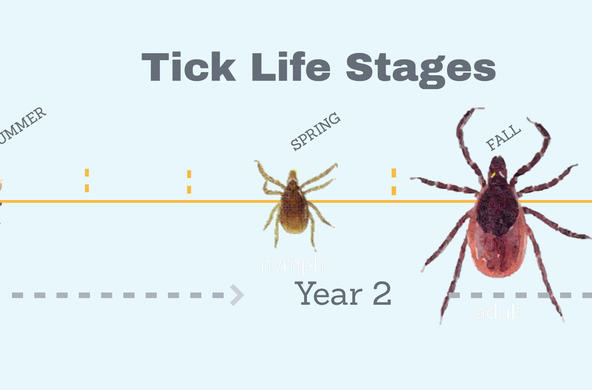Michael Radonich remembers the day he got Lyme disease: It was late August 2012, the beginning of his first semester at the Wharton School in Philadelphia. He and his classmates had boarded buses for a day of ropes courses and bonding activities at a campground in the Pennsylvania woods.
About two weeks later, Radonich suddenly awoke to shooting pains in his scalp, as if someone had clipped electrodes to his temples. His heart rate began fluttering between 60 and 140 beats per minute. His experienced severe double vision, and then the left side of his body went numb. He was 28 years old, much too young to be having a stroke.
The doctors at the student health center couldn't figure it out, so Radonich went to his family doctor in Connecticut, who couldn't figure it out either. In all, Radonich saw 15 doctors, including specialists in four states, and not one could explain his symptoms.
"One told me I had developed a cardiac problem overnight," he says. Another was convinced he had "classic multiple sclerosis." He spent six months searching in vain for the cause of what ailed him. He took medical leave from school before Thanksgiving.
Finally, in early 2013, he saw a doctor who ran some tests that came up positive for Lyme disease, a tick-borne infection that afflicts more than 300,000 Americans every year. A tick had bitten him that day in the woods.
Long story short, Radonich spent the next two years on intravenous antibiotics—having powerful drugs pumped into his body on a daily basis—and living with his parents as a virtual invalid.
But even though Radonich lost those two years and spent tens of thousands of dollars on treatments not covered by insurance, he's now doing better and hopes to one day say he's cured. He got engaged in March, graduated from Wharton in May, and is working at a private equity firm in Boston. But not everyone who tangles with ticks is so lucky.
WHAT IS YOUR REAL RISK OF LYME DISEASE?
Lyme is the most common vector-borne disease in America, dwarfing West Nile, Zika, and chikungunya. More than 40,000 cases of diagnosed Lyme disease are reported to the CDC each year, but the true number of new infections, the agency estimates, could be as high as 376,000.
Since it first appeared in Old Lyme, Connecticut, in 1975, where people started suffering from a mysterious outbreak of arthritis, the disease has spread along the Northeast coast, with other clusters in the Upper Midwest states of Wisconsin and Minnesota and along the coasts of California and Oregon.
I live in a wooded area in central Pennsylvania, where Lyme is common. Many of my friends and neighbors have gotten the disease. For most, it was straightforward: a tick bite, the classic bull's-eye rash, some joint pain and flu-like symptoms, and then two to four weeks of antibiotics until it went away.
These are the sorts of cases envisioned under the treatment guidelines of the Infectious Diseases Society of America (IDSA). But not every case fits into this shoebox.
Take, for example, Fred Long. Now an attorney in Lebanon, Pennsylvania, Long was a 24-year-old just entering law school when he started to feel bad, with severe knee pain and a lack of energy. Then his jaw locked up, and some days he could barely get out of bed. Long eventually persuaded his doctor to test for Lyme. (The doc was reluctant because Long had never had the rash and couldn't remember being bitten by a tick.) "My test came back negative," he says.
It took him 11 more months of feeling terrible before he finally saw another doctor, a Lyme specialist. This time he tested positive for Lyme antibodies. But the disease was now well advanced. He spent a year on antibiotics. Now 30, he's feeling better, but he's still not 100 percent.
That's because the longer you go without treatment, the worse the symptoms can become. A delay of a few months can turn a relatively easy-to-treat infection into a serious, systemic problem. Long was initially misdiagnosed because his case didn't fit the IDSA guidelines.
"If you're lucky, you'll see the rash and your doctor can start treatment. If you don't, then your treatment could be delayed," says Brian Fallon, M.D., director of the Lyme and Tick-Borne Diseases Research Center at Columbia University.
Indeed, several physicians have been brought up on disciplinary charges for not following the guidelines. This has a chilling effect, some Lyme survivors say, making doctors more reluctant to diagnose the disease.
"In my opinion, an enormous amount of harm has come to a great many patients from doctors' strict observance of the IDSA guidelines," says Steven Phillips, M.D., a Connecticut-based specialist in tick-borne diseases. The guidelines not only blind doctors to the likelihood of disease but also are cited by insurance companies to justify their denial of coverage for long-term antibiotic treatments.
WHY LYME IS STILL SPREADING
There's a popular Internet conspiracy theory that goes like this: Lyme disease was created by scientists on Plum Island, off the Long Island coast, in a secret government laboratory devoted to germ warfare. While there's no truth to this rumor, the way the disease works is just as diabolical.
Most people think deer are the main spreaders of Lyme; after all, we know the disease mostly comes from the bite of the common deer tick, and deer are everywhere Lyme cases occur. But the true villains are much smaller and more numerous.
On a Thursday morning in May, I follow researcher Kelly Oggenfuss into the forest on the grounds of the Cary Institute of Ecosystem Studies in Millbrook, New York. Stopping at an orange flag, she picks up a footlong metal box. With a gloved hand, she extracts a terrified-looking rodent. "These guys," she says, pinching the mouse between the shoulder blades, "are really good at passing along Lyme disease to ticks."
This one, Mouse E7243, is particularly efficient. Oggenfuss quickly discerns that the field mouse is pregnant and lactating. Even though it's only May, it's on its second litter. It is also carrying a tick. "See it? Between the tips of my tweezers?"
Actually I don't, until I do; it's a smudge the size of a poppy seed. The tick is a nymph, a juvenile. According to research by Oggenfuss's colleague, Richard Ostfeld, Ph.D., some 35 percent of nymphs in this area are infected with Borrelia burgdorferi, the bacteria behind Lyme.
And if this young tick weren't already carrying burgdorferi, it probably would be soon: 75 percent of the mice in these woods harbor the disease. "They're the reservoir," says Ostfeld later in his office. "Their bloodstreams are crawling with these bacteria, but they feel no ill effects."
Blowing on the mouse to ruffle its fur, Oggenfuss quickly discovers two larvae as well. They're barely visible, smaller than the period at the end of this sentence. The good news is that larval ticks aren't infected with Lyme (yet), so if one bites, you're probably okay.
The bad news: After dining on the blood of Mouse E7243, it has a 75 percent chance of picking up Lyme bacteria. Which means that within a few days, there will probably be three more Lyme-infected ticks in these woods—along with yet another litter of field mice to carry and transmit the disease to still more ticks.
What's more, these small wooded areas are especially conducive to the spread of Lyme. "Intact nature protects us," Ostfeld says. "It's only when we chop it up and make it uninhabitable for predators, the hawks and foxes, that we increase risk. What we've found is that small forest patches, 1 to 2 acres, are the riskiest places for Lyme disease. And that's where we put our houses."
LYME TESTING: A HUGE FAIL
It doesn't take long before I start to wonder: Are Borrelia burgdorferi bacteria swimming around in my bloodstream?
I spend a lot of time outdoors walking my dog and riding my mountain bike. I've picked ticks off of my body, although I've never found one that was engorged, which is lucky.
According to Ostfeld, there's a grace period of about 24 hours between when the tick attaches itself to you and the burgdorferi start flowing.
Still, I worry. Ticks are everywhere: On my dog, on the furniture, even on the inside windshield of my car. I've never had any of the classic symptoms, but I often feel fatigued and my brain sometimes gets foggy, which are two more typical (if subjective) symptoms of long-term Lyme. I often feel achy too—but that could simply be because I'm 49 years old.
When I return home from a bike ride and find yet another tick embedded in my leg, I make an appointment to get tested. My doctor scrutinizes the spot, quizzes me thoroughly, and then reluctantly agrees to do the test.
Under the IDSA guidelines, which he follows exactly, in the absence of a rash a Lyme disease diagnosis requires two positive blood tests.
The first is a screening test called an ELISA to determine whether antibodies are present. If that's positive or inconclusive, part two is a Western Blot, a standard analysis that searches for evidence of antibodies associated with the Lyme disease bacteria.
You'd think a bug this potent would be easy to detect. It's not; Lyme disease tests are notoriously inaccurate in the early stage of the infection. In patients with a recent bull's-eye rash, the ELISA turns up positive less than half the time, according to Elitza Theel, Ph.D., an expert in blood testing at the Mayo Clinic. "If you've noticed that you have a tick bite and a rash, you really don't need to be tested," she says. You're infected.
It's when you don't recognize the rash, or there isn't one, that problems arise. Experts say it's important to treat Lyme as early as possible. But the antibodies take a couple of weeks to show up in your bloodstream.
This, in part, is because of another evil-genius feature of burgdorferi: As it sits in the tick's mouthpart waiting to dive into your bloodstream, it tricks its host into creating a chemical disguise that renders it invisible to your immune system. Meanwhile, even though you won't test positive for at least two more weeks, the infection is progressing.
On the plus side, a positive ELISA is more likely in patients who have established Lyme disease. But when they go on to the confirming Western Blot, more problems can arise.
For one thing, although the test covers 13 antibodies that are almost all unique to Lyme, the guidelines require multiple hits before a diagnosis can be made. Also, research reveals wide variation among the many different labs that offer Lyme testing.
One study found that some labs failed to detect Lyme antibodies via Western Blot in a few people with confirmed Lyme disease. It also found that some patients with Lyme bacteria test positive even though they're fine.
So it's small comfort when my initial Lyme test comes back negative. I get tested again, this time with another, more sensitive ELISA known as the C6. This time it comes back positive—slightly.
So there are Lyme antibodies in my body, potentially. The doctor also orders a Western Blot, and it shows only one antibody out of 13. Officially, I am negative. But there is a whiff of Lyme exposure—and a whole lot of uncertainty.
THE SCARY TRUTH ABOUT LYME DISEASE
Once it's made its way inside the human body, burgdorferi hides in plain sight. It enters by way of the tick's salivary secretions and then quickly migrates into the skin. From there it travels through the bloodstream to other "fixed tissues," such as your joints, heart, and brain, explains Peter Krause, M.D., a senior research scientist at Yale School of Public Health. "It doesn't stay in the blood very long."
Scientists believe this partly explains why Lyme is so hard to detect and treat. Two places where burgdorferi especially like to hang out are the brain and central nervous system, says Amiram Katz, M.D., a former professor of neurology at Yale. "They feel comfortable in those places because the immune system there is weak," he says. "It's a less hostile environment."
No wonder the neurological symptoms of Lyme are so intractable. Around 20 percent of diagnosed Lyme patients—and perhaps many more—say they continue to have symptoms of the disease long after treatment. But this, too, is controversial.
"There is no such thing as 'chronic Lyme,'" points out Gary Wormser, M.D., chief author of the IDSA guidelines. The official term is "post-treatment Lyme disease syndrome." Is it a distinction without a difference?
Is it a distinction without a difference? Perhaps. The problem arises because antibiotics don't kill all the burgdorferi; it's not like spraying kitchen counters with disinfectant. Some of the bacteria appear to withstand antibiotics and survive, at least for a time. In fact, burgdorferi were found in Otzi the Iceman, who was frozen into a glacier in Europe 5,000 years ago.
Are these latent Lyme bacteria alive? They may be, according to an experiment carried out by a team of researchers led by Adriana Marques, M.D.,of the National Institute of Allergy and Infectious Diseases.
The scientists recruited volunteers who'd been infected with Lyme in the past, and then placed laboratory-raised, disease-free ticks on their bodies. The ticks ended up harvesting live burgdorferi from two of the 23 volunteers, meaning those study participants still had remnants of the disease in their bodies.
Some doctors believe this may explain why some people continue to experience symptoms after treatment.
Add to this the recent discovery of so-called "persister" forms of Lyme bacteria. "They change form and essentially become unrecognizable, and more resistant to stress and antibiotics," says Ying Zhang, M.D., a microbiologist at Johns Hopkins Bloomberg School of Public Health and one of the first researchers to study the connection between Lyme and these types of bacteria.
This may explain why long-term antibiotic treatment, favored by many Lyme specialists, has mixed results. It works for some patients, such as Michael Radonich, but not for others.
So the symptoms reported by "chronic" Lyme patients must have some other cause—perhaps an autoimmune reaction or even a co-infection. "The majority of people I see who have been diagnosed with chronic Lyme have similar symptoms but don't have any evidence of ever having had Lyme disease," says Dr. Wormser.
Some physicians who treat Lyme patients believe that the remnant bacteria secrete substances that make people continue to feel sick.
"There's an inflammatory response in the body, molecules called inflammatory cytokines that have been shown to be present in Lyme and fibromyalgia," says Richard Horowitz, M.D., who has 30 years of experience treating the disease. "They make you tired. They give you headaches, memory and concentration problems, muscle pain, numbness, neuropathy. Your moods go off and you can't sleep at night.
You can have migratory muscle pain, joint pain, and nerve pain. Those are the hallmarks of Lyme."
It can even affect libido. "Men don't like to talk about those symptoms," he adds.
The problem boils down to knowledge. Because there's so much variation in diagnosis and treatment, patients can end up in limbo—and vulnerable to practitioners selling dubious, unproven, and expensive cures, such as "chelation therapy" and electromagnetic "Rife" machines.
Indeed, the doctor who tested me insisted that I come in and be put on antibiotics immediately. His fee for an initial consultation was $2,000. As in any war, truth is the first casualty and also the last.
"If you think about disease and treatment, the first thing you need to do is identify the bug or bugs that are causing the disease. Next you have to be able to reliably test for those bugs.
And only then can you start testing the effectiveness of a given treatment," says Adam Sussman, a 43-year-old firefighter who has been battling the disease for more than two years, spending thousands of dollars of his own money. "How can you say if a given treatment regimen works if they can't even determine if you have it?"





